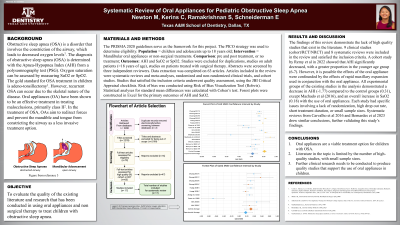Growth & Development
198 - Systematic Review of Oral Appliances for Pediatric Obstructive Sleep Apnea


Margaret Newton, DDS (she/her/hers)
Pediatric Dental Resident
Texas A & M University -—Baylor College of Dentistry, Dallas, TX
Texas A&M School of Dentistry
Dallas, Texas, United States- CK
Carolyn Kerins, DDS, PhD
Texas A&M School of Dentistry
- SR
Sudha Ramakrishnan, MS
Baylor Health Sciences Library
- RE
Ryan Eldin, BS
Texas A&M School of Dentistry
- VL
Vivian Liu, BS
Texas A&M School of Dentistry
- ES
Emet Schneiderman, PhD
Texas A&M School of Dentistry
- ES
Emet Schneiderman, PhD
Texas A&M University School of Dentistry
Dallas, Texas, United States - CK
Carolyn Kerins, DDS, PhD
Associate Professor & Grad Program Director
Texas A&M University School of Dentistry
Dallas, Texas, United States
Presenting Author(s)
Co-Author(s)
Research Mentor(s)
Program Director(s)
Purpose: To determine the quality of the existing literature and research that has been conducted in using oral appliances to treat children with obstructive sleep apnea.
Methods: The PRISMA 2020 guidelines serve as the framework for this project. With expertise from a librarian at Baylor Health Sciences library, Covidence software was utilized to import a total of 2278 references from 8 databases including Cochrane, DOSS, Embase, Google Scholar, Ovid MEDLINE, PubMed, Scopus, and Web of Science in August 2023. Abstracts were screened by three independent reviewers. For inclusion in the review, studies were required to have objective sleep respiration outcome variables such as the apnea hypopnea index (AHI) after at least 4 weeks of therapy with an oral appliance in children with sleep disturbed breathing under the age of 18. Disagreements between the junior investigators were resolved by the senior investigator. Data extraction was completed on 63 articles that met inclusion criteria. Types of articles included in the review were systematic reviews and meta-analyses, randomized and non-randomized clinical trials, and cohort studies. Studies that satisfied the inclusion criteria underwent quality assessment, using the JBI Critical Appraisal checklists. Risk of bias was conducted using Risk of Bias Visualization Tool (Robvis). Statistical analyses for standard mean differences was calculated with Cohen’s test. Forest plots were constructed in Excel for the primary outcomes of AHI and SaO2.
Results: The findings of this review demonstrate the lack of high quality studies that exist in the literature. 9 clinical studies (cohort/RCT/NRCT) and 8 systematic reviews were included in the review and satisfied the inclusion criteria. A cohort study by Remy et al in 2022 showed that AHI significantly decreased, with a greater proportion in the younger age group (6-7). However, it is possible the effects of the oral appliance were confounded by the effects of rapid maxillary expansion used in conjunction with the oral appliance. All experimental groups of the existing studies in the analysis demonstrated a decrease in AHI (-1.77) compared to the control group’s (0.31), except Machado et al (2016), and an overall increase in SaO2 (0.18) with the use of oral appliances. Each study had a specific issues involving a lack of randomization, high drop out rate, short treatment duration, or small sample sizes. Systematic reviews from Carvalho et al 2016 and Bernardes et al 2023 drew similar conclusions, further validating this study’s findings.
Conclusion: Oral appliances are a viable treatment option for children with OSA.
Literature in the topic is limited by the number of high quality studies, with small sample sizes. Further clinical research needs to be conducted to produce quality studies that support the use of oral appliances in children.
Identify Supporting Agency and Grant Number: Research supported by the Baylor Health Sciences Library and Texas A&M School of Dentistry

.jpg)